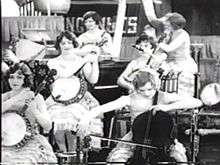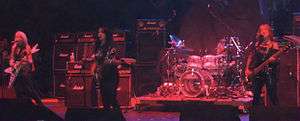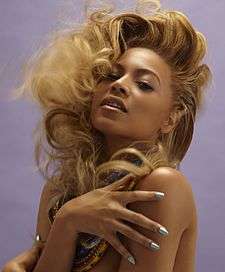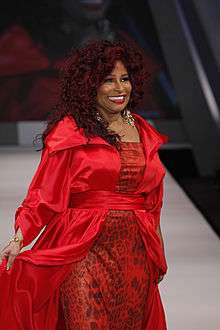Women in rock

Women in rock describes the role of women singers, instrumentalists, record producers and other music professionals in rock music and popular music and the many subgenres and hybrid genres that have emerged from these genres. Women have a high prominence in many popular music styles as singers. However, professional women instrumentalists are uncommon in popular music, especially in rock genres such as heavy metal. "[P]laying in a band is largely a male homosocial activity, that is, learning to play in a band is largely a peer-based... experience, shaped by existing sex-segregated friendship networks.[1] As well, rock music "...is often defined as a form of male rebellion vis-à-vis female bedroom culture."[2]
In popular music, there has been a gendered "distinction between public (male) and private (female) participation" in music.[2] "[S]everal scholars have argued that men exclude women from bands or from the bands'rehearsals, recordings, performances, and other social activities."[3] "Women are mainly regarded as passive and private consumers of allegedly slick, prefabricated – hence, inferior – pop music..., excluding them from participating as high status rock musicians."[3] One of the reasons that there are rarely mixed gender bands is that "bands operate as tight-knit units in which homosocial solidarity – social bonds between people of the same sex... – plays a crucial role."[3] In the 1960s pop music scene, "[s]inging was sometimes an acceptable pastime for a girl, but playing an instrument...simply wasn't done."[4]
"The rebellion of rock music was largely a male rebellion; the women—often, in the 1950s and '60s, girls in their teens—in rock usually sang songs as personæ utterly dependent on their macho boyfriends...". Philip Auslander says that "Although there were many women in rock by the late 1960s, most performed only as singers, a traditionally feminine position in popular music". Though some women played instruments in American all-female garage rock bands, none of these bands achieved more than regional success. So they "did not provide viable templates for women's on-going participation in rock".[5]:2–3 In relation to the gender composition of heavy metal bands, it has been said that "[h]eavy metal performers are almost exclusively male"[6] "...[a]t least until the mid-1980s" [7] apart from "...exceptions such as Girlschool."[6] However, "...now [in the 2010s] maybe more than ever–strong metal women have put up their dukes and got down to it",[8] "carv[ing] out a considerable place for [them]selves."[9] When Suzi Quatro emerged in 1973, "no other prominent female musician worked in rock simultaneously as a singer, instrumentalist, songwriter, and bandleader".[5]:2 According to Auslander, she was "kicking down the male door in rock and roll and proving that a female musician ... and this is a point I am extremely concerned about ... could play as well if not better than the boys".[5]:3
A number of these artists are also notable for singing and songwriting, but they are listed here for their instrumental skills:
- Joni Mitchell
- Bonnie Raitt
- Nancy Wilson
- Kaki King
- Orianthi
- Sister Rosetta Tharpe
- Jennifer Batten
- Mary Ford
- Lita Ford
- Joan Jett
All-female bands and girl groups
An all-female band is a musical group in popular music genres such as rock, blues, jazz and related genres which is exclusively composed of female musicians. This is distinct from a girl group, in which the female members are solely vocalists, though this terminology is not universally followed.[10] While all-male bands are common in many rock and pop bands, all-female bands are less common.
A girl group is a music act featuring several female singers who generally harmonize together. The term "girl group" is also used in a narrower sense within English-speaking countries to denote the wave of American female pop music singing groups which flourished in the late 1950s and early 1960s between the decline of early rock and roll and the British Invasion, many of whom were influenced by doo-wop style.[11][12] All-female bands are sometimes also called girl groups.[13]

1930s-1960s
In the Jazz Age and during the 1930s, all-female bands such as The Blue Belles, the Parisian Redheads (later the Bricktops), Lil-Hardin's All-Girl Band, The Ingenues, The Harlem Playgirls, Phil Spitalny's Musical Sweethearts and "Helen Lewis and Her All-Girl Jazz Syncopators" were popular.Ina Ray Hutton led an all-girl band, the Melodears, from 1934 to 1939. Eunice Westmoreland, under the name Rita Rio, led an all-female band appearing on NBC Radio and for Vitaphone and RKO. A Polish group Filipinki was established in 1959.[14]
Groups composed solely of women began to emerge with the advent of rock and roll. Among the earliest all-female rock bands to be signed to a record label were Goldie & the Gingerbreads, to Atlantic Records in 1964, The Pleasure Seekers with Suzi Quatro to Hideout Records in 1964 and Mercury Records in 1968, The Feminine Complex to Athena Records in 1968, and Fanny (who pioneered the all-female band sound in the early to mid-1970s) in 1969 when Mo Ostin signed them to Warner Bros. Records. There were also others, such as The Liverbirds (1962–1967), the Ace of Cups (1967), The Heart Beats (1968), and Ariel (1968–1970).
1970s-1980s
In 1971 Fanny became the first all-female band to reach the Hot 100's top 40, with "Charity Ball" peaking at No. 40. In 1975, the Canadian duo of sisters, Kate and Anna McGarrigle, recorded the first of a string of albums. The Runaways were an early commercially successful, hard-edged, all-female hard rock band, releasing their first album in 1976: band members Joan Jett, Cherie Currie and Lita Ford all went on to solo careers. The 1980s, for the first time, saw long-sought chart success from all-female bands and female-fronted rock bands. On the Billboard Hot 100-year-end chart for 1982[15] Joan Jett's I Love Rock 'n' Roll at No. 3 and the Go-Go's We Got the Beat at No. 25 sent a message out to many industry heads that females who could play could bring in money.
Punk
In the United Kingdom, the advent of punk in the late 1970s with its "anyone can do it" ethos led to women making significant contributions.[16][17] In contrast to the rock music and heavy metal scenes of the 1970s, which were dominated by men, the anarchic, counter-cultural mindset of the punk scene in mid- and late 1970s encouraged women to participate. "That was the beauty of the punk thing," Chrissie Hynde later said." [Sexual] discrimination didn't exist in that scene."[18] This participation played a role in the historical development of punk music, especially in the U.S. and U.K. at that time, and continues to influence and enable future generations.[19]
Rock historian Helen Reddington states that the popular image of young punk women musicians as focused on the fashion aspects of the scene (fishnet stockings, spiky blond hair, etc.) was stereotypical. She states that many, if not most women punks were more interested in the ideology and socio-political implications, rather than the fashion.[20][21] Music historian Caroline Coon contends that before punk, women in rock music were virtually invisible; in contrast, in punk, she argues "[i]t would be possible to write the whole history of punk music without mentioning any male bands at all -- and I think a lot of [people] would find that very surprising."[22][23] Johnny Rotten wrote that ‘During the Pistols era, women were out there playing with the men, taking us on in equal terms ... It wasn’t combative, but compatible.’[24] Women were involved in bands such as The Slits, The Raincoats, Mo-dettes, and Dolly Mixture, The Innocents.
Others take issue with the notion of equal recognition, such as guitarist Viv Albertine, who stated that "the A&R men, the bouncers, the sound mixers, no one took us seriously.. So, no, we got no respect anywhere we went. People just didn't want us around."[25][26] The anti-establishment stance of punk opened the space for women who were treated like outsiders in a male-dominated industry. Sonic Youth's Kim Gordon states, "I think women are natural anarchists, because you're always operating in a male framework."[27]
Heavy metal

The all-female heavy metal band Girlschool, from South London, formed in 1978 out of the ashes of Painted Lady. While somewhat successful in the UK, they became better known in the early 1980s. One of the original members of the band, Kathy Valentine departed to join the all-female band The Go-Gos', switching from guitar to bass. Among Girlschool's early recordings was an EP titled "The St. Valentines Day Massacre" which they recorded with Bronze label-mates Motörhead under the name Headgirl. In 1974, The Deadly Nightshade, a rock/country band, was signed by Phantom.
1990s-2000s
In the 1990s, musician's magazines were starting to view female musicians more seriously, putting Bonnie Raitt[30][31] and Tina Weymouth[32] on their covers. While The Go-Go's and The Bangles, both from the LA club scene, were the first all-female rock bands to find sustained success, individual musicians paved the way for the industry to seek out bands that had female musicians.
In the 1990s, bands such as Hole, Super Heroines, The Lovedolls and L7 became popular, while demonstrating on stage, and in interviews, a self-confident and "bad" attitude at times, always willing to challenge assumptions about how an all-female band should behave. Courtney Love described the other females in Hole as using a more "lunar viewpoint" in their roles as musicians.[33] In the 1990s, the punk, female-led Riot Grrrl genre was associated with bands such as Bratmobile and Bikini Kill.

Singers
Singers in popular music perform the vocals for bands and other music groups, which may range in size from a duo or a power trio to a large jazz big band. Singers typically do both live performances and studio recordings. Singers who do live performances may sing in small venues such as coffeehouses or nightclubs, or they may perform in larger venues ranging from arts centres to stadiums. Some singers also perform in music videos, which are used to promote the songs. In some styles of music, singers may play a rhythm section instrument, such as rhythm guitar, electric bass or a percussion instrument while they sing. In some styles of pop, singers perform choreographed dance moves during the show. Two well-known examples of pop singers who do elaborate dance routines in their live shows are Madonna and Britney Spears.
Singer-songwriter and music producer Bjork has commented on how "...women's labor and expertise—inside and outside of the music industry—go unnoticed." She has stated that "[I]t's invisible, what women do," and "[I]t's not rewarded as much."[34] Bjork states "...that her male collaborators are typically credited for the sound of her records; because on stage she mainly sings, there is a widespread assumption that she neither produces [as a music producer] nor plays an instrument."[34] In 2015, "while accepting the Woman of the Year honor at this year's Billboard Women in Music event", Lady Gaga commented on the "...difficulties of being a female recording artist." She said it "...is really hard sometimes for women in music. It's like a f[uck]ing boys club that we just can't get in to." She stated that she "...tried for so long...to be taken seriously as a musician for my intelligence more than my body", yet she felt that others in the industry did not believe that women could have a "... musical background...[or] understand what you're doing because you're a female." [35]

Despite funk’s popularity in modern music, few people have examined the work of funk women. As cultural critic Cheryl Keyes explains in her essay "She Was too Black for Rock and too hard for Soul: (Re)discovering the Musical Career of Betty Mabry Davis," most of the scholarship around funk has focused on the cultural work of men. She states that "Betty Davis is an artist whose name has gone unheralded as a pioneer in the annals of funk and rock. Most writing on these musical genres has traditionally placed male artist like Jimi Hendrix, George Clinton (of Parliament-Funkadelic), and bassist Larry Graham as trendsetters in the shaping of a rock music sensibility"[36] (35). Notable funk women include Chaka Khan, Labelle, Brides of Funkenstein, Klymaxx, Mother's Finest, and Betty Davis.
Below are some of the top-earning female singers in the 2010s. Another way of selecting the most notable singers for this section would be by critical acclaim, but this is a more subjective criteria than earnings. Almost all of these singers are also songwriters, and some are also music producers:
- Lady Gaga
- Taylor Swift
- Katy Perry
- Beyoncé Knowles
- Rihanna
- Adele
- Madonna
- Pink
- Carrie Underwood
- Celine Dion
- Britney Spears
- Alicia Keys
Music critics

Music critics review live concerts and sound recordings for magazines, newspapers, books and websites. According to Anwen Crawford, a writer for The Monthly, the "problem for women [popular music critics] is that our role in popular music was codified long ago", which means that "[b]ooks by living female rock critics (or jazz, hip-hop, and dance-music critics, for that matter) are scant." Crawford notes that the "...most famous rock-music critics—Robert Christgau, Greil Marcus, Lester Bangs, Nick Kent—are all male."[34]
Sociologist Simon Frith noted that pop and rock music "are closely associated with gender; that is, with conventions of male and female behaviour."[37] According to Holly Kruse, both popular music articles and academic articles about pop music are usually written from "masculine subject positions."[38] As well, there are relatively few women writing in music journalism: "By 1999, the number of female editors or senior writers at Rolling Stone hovered around...15%, [while] at Spin and Raygun, [it was] roughly 20%."[39] Criticism associated with gender was discussed in a 2014 Jezebel article about the struggles of women in music journalism, written by music critic Tracy Moore, previously an editor at the Nashville Scene.[40]
The American music critic Ann Powers, as a female critic and journalist for a popular, male-dominated industry, has written critiques the perceptions of sex, racial and social minorities in the music industry. She has also written about feminism.[41][42] In 2006 she accepted a position as chief pop-music critic at the Los Angeles Times, where she succeeded Robert Hilburn.[43] In 2005, Powers co-wrote the book Piece by Piece with musician Tori Amos, which discusses the role of women in the modern music industry, and features information about composing, touring, performance, and the realities of the music business.
Anwen Crawford contributed to Jessica Hopper’s book of essays and profiles entitled The First Collection of Criticism by a Living Female Rock Critic.[44] Crawford's article "...explores women's long struggle for visibility and recognition in the field of rock criticism, even though we’ve been helping to pioneer it from the start".[44] Crawford states that “[t]he record store, the guitar shop, and now social media: when it comes to popular music, these places become stages for the display of male prowess"; "[f]emale expertise, when it appears, is repeatedly dismissed as fraudulent. Every woman who has ever ventured an opinion on popular music could give you some variation [of this experience] ...and becoming a recognized “expert” (a musician, a critic) will not save [women] from accusations of fakery.” [44]
Notable popular music critics include:
- Tanja Bakić
- Raquel Cepeda
- Ann Powers
- Joy Press
- Linda Solomon
- Lillian Roxon
- Ellen Willis, Out of the Vinyl Deeps (2011)
- Penny Valentine
References
- ↑ Julian Schaap and Pauwke Berkers. "Grunting Alone? Online Gender Inequality in Extreme Metal Music" in Journal of the International Association for the Study of Popular Music. Vol.4, no.1 (2014) p. 101-102
- 1 2 Julian Schaap and Pauwke Berkers. "Grunting Alone? Online Gender Inequality in Extreme Metal Music" in Journal of the International Association for the Study of Popular Music. Vol.4, no.1 (2014) p. 102
- 1 2 3 Julian Schaap and Pauwke Berkers. "Grunting Alone? Online Gender Inequality in Extreme Metal Music" in Journal of the International Association for the Study of Popular Music. Vol.4, no.1 (2014) p. 104
- ↑ Erika White (2015-01-28). "Music History Primer: 3 Pioneering Female Songwriters of the '60s | REBEAT Magazine". Rebeatmag.com. Retrieved 2016-01-20.
- 1 2 3 Auslander, Philip (28 January 2004). "I Wanna Be Your Man: Suzi Quatro's musical androgyny" (PDF). Popular Music. United Kingdom: Cambridge University Press. 23 (1): 1–16. doi:10.1017/S0261143004000030. Retrieved 25 April 2012.
- 1 2 Brake, Mike (1990). "Heavy Metal Culture, Masculinity and Iconography". In Frith, Simon; Goodwin, Andrew. On Record: Rock, Pop and the Written Word. Routledge. pp. 87–91.
- ↑ Walser, Robert (1993). Running with the Devil:Power, Gender and Madness in Heavy Metal Music. Wesleyan University Press. p. 76.
- ↑ Eddy, Chuck (1 July 2011). "Women of Metal". Spin. SpinMedia Group.
- ↑ Kelly, Kim (17 January 2013). "Queens of noise: heavy metal encourages heavy-hitting women". The Telegraph.
- ↑ For example, vocalists Girls Aloud are referred to as a "girl band" in OK magazine and the Guardian, while Girlschool are termed a "girl group" at the imdb and Belfast Telegraph.
- ↑ Rutledge, Meredith E. (2013-04-15). "The Fabulous Girl Groups | The Rock and Roll Hall of Fame and Museum". Rockhall.com. Retrieved 2014-06-04.
- ↑ "Girl Groups - A Short History". History-of-rock.com. Retrieved 2014-06-04.
- ↑ For example, vocalist groups Sugababes and Girls Aloud are referred to as "girl bands" Meet the duo dressing Girls Aloud OK magazine, 20 March 2009; The nation's new sweetheart The Observer, 9 November 2008; while instrumentalists Girlschool are termed a "girl group" Biography for Girlschool Internet Movie Database; The Hedrons Belfast Telegraph, 19 January 2007
- ↑ "Wyborcza.pl". Szczecin.gazeta.pl. 1980-01-01. Retrieved 2016-01-20.
- ↑ "The Billboard Hot 100 1982", Billboard. Retrieved 30 October 2008.
- ↑ Coon, Caroline (1977). 1988: The New Wave Punk Rock Explosion. London: Omnibus/Hawthorne Books. ISBN 978-0801561290.
- ↑ Berman, Judy. "15 Essential Women Punk Rock Icons". Flavorwire. Retrieved 25 November 2015.
- ↑ "Women of Punk and Post-Punk Music". Biography.com. Retrieved 26 November 2015.
- ↑ "Why Women in Punk?". Women in Punk. Punk77.co.uk. Retrieved 26 November 2015.
- ↑ Reddington, Helen (2012). The Lost Women of Rock Music: Female Musicians of the Punk Era. Ashgate/Equinox Publishing. ISBN 978-1845539573. Retrieved 26 November 2015.
- ↑ Woronzoff, Elizabeth. "The Lost Women of Rock Music' Is an Important Work, But a Replay of the Same Old Themes". Pop Matters. Retrieved 26 November 2015.
- ↑ Conference proceedings (September 2001). "No Future?". University of Wolverhampton.
- ↑ Reddington, Helen (1977). Introduction: The Lost Women of Rock Music (PDF). London: Ashgate. ISBN 9780754657736.
- ↑ Lydon, John (1995). Rotten: No Irish, No Blacks, No Dogs. London: Coronet. p. 378. ISBN 978-0312428136.
- ↑ Petridis, Alexis. "The Slits' Viv Albertine on punk, violence and doomed domesticity". The Guardian. Retrieved 27 November 2015.
- ↑ Andrews, Charlotte Richardson (July 3, 2014). "Punk has a problem with women. Why?". The Guardian. Retrieved 27 November 2015.
- ↑ Hall, Rock. "Women Who Rock: 10 Essential Punk Songs". The Rock & Roll Hall of Fame Museum. Retrieved 27 November 2015.
- ↑ "Girlschool biography". Girlschool Official Website. Retrieved 27 January 2011.
- ↑ "Reviews". Classic Rock (magazine). Girlschool official website. December 2004. Retrieved 3 September 2010.
...apparently listed in The Guinness Book Of Records for being the world’s longest-surviving all-female rock band
- ↑ Bonnie Raitt cover story, Guitar Player Magazine, May 1977
- ↑ Bonnie Raitt cover story, Guitar Player Magazine, July 1998
- ↑ "Tina Weymouth & David Byrne, The Talking Heads" (cover story), Guitar Player Magazine, March 1984
- ↑ Boder, Christopher. "The Hole Story", Buzz, Page 13, Vol VII, Issue 70. October 1991.Most women in rock are only repeating what men have done. The women in this band are not doing that. We're coming at things from a more feminine, lunar, viewpoint.
- 1 2 3 Crawford, Anwen. "The World Needs Female Rock Critics" in The Atlantic. 26 May 2015. Available at: http://www.newyorker.com/culture/cultural-comment/the-world-needs-female-rock-critics
- ↑ KAREN MIZOGUCHI Lady Gaga Calls Music Industry a 'F---king Boys Club' in People. 12/12/2015 http://www.people.com/article/lady-gaga-music-industry-boys-club-billboard
- ↑ Cheryl Keyes, "She Was too Black for Rock and too hard for Soul: (Re)discovering the Musical Career of Betty Mabry Davis" 35.
- ↑ Frith, Simon, "Pop Music" in S. Frith, W. Stray and J. Street, The Cambridge Companion to Pop and Rock (Cambridge University Press, 2001), p. 226.
- ↑ Jones, Steve, ed. (2002). Pop Music and the Press. Temple University Press. ASIN B00EKYXY0K. ISBN 9781566399661. p. 134
- ↑ McLeod (2002) at 94, quoted in Leonard, Marion (2007). "Meaning Making in the Press". Gender in the Music Industry: Rock, Discourse, and Girl Power. Aldershot, Hampshire, England: Ashgate Publishing, Ltd. p. 67. ISBN 9780754638629.
- ↑ Moore, Tracy (20 March 2014). "Oh, the Unbelievable Shit You Get Writing About Music as a Woman". Jezebel.
- ↑ "Why I Write: Ann Powers Reflects on Writing About Rock". Retrieved 19 December 2014.
- ↑ "Pop music critic Ann Powers searches for the language of rock and roll". Retrieved 19 December 2014.
- ↑ Patrick MacDonald, Ann Powers named L.A. Times pop critic, Seattle Times, 7 March 2006
- 1 2 3 http://www.thefader.com/2015/06/03/the-world-doesnt-need-more-female-music-critics